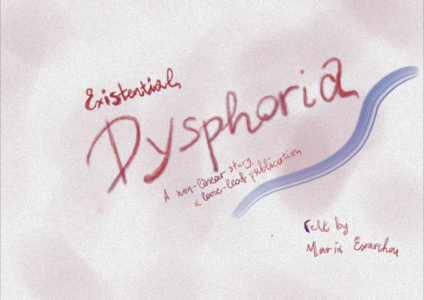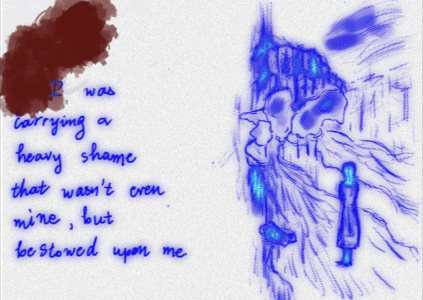User:Mxrwho/The Final Project/The what, the why, the how
| I was born a female.
... I was born a female, and thus I was declared “girl”. ... Of course, being a “girl” came with its own set of desired characteristics: For pre-puberty those would be “cuteness” and “mildness”. I was destined to fail in both. ... I was strong-willed, resolute, talkative and loud. On good days those characteristics would make me a “leader” but on bad days and since all I could actually lead was my shiny army of marbles, they just made me “stubborn”. |
|---|
The what
In this project I want to experiment with biases and the processes surrounding them.
During the public moment I presented an installation on the topic of labeling and stereotyping. I used mirrors,
old photographic material,
and a soundboard
in order to create a narrative environment that would invite visitors to explore the effect of biases and labeling through non-linear storytelling and interaction, and to gather responses through a feedback form and through direct communication.
The experience was meant to be progressive but not necessarily linear and visitors were welcome to interact with the objects (change the page order of the non-linear, loose-leaf publication, pick up the photos, bring the cassette player close to their ears, play with the volume and the buttons, play with the soundboard, use markers and pens to leave their feedback).
In the coming months the project will be enriched and further experiments will be conducted: the narrative structure will be strengthened with the addition of visual elements (video work), the generative element will be enhanced (offering more capabilities with the soundboard, such as the addition of sounds and a recording option). The thesis will become an integral part of the project, as it is a narrative that follows and demonstrates the explored topics. The thesis (or at least parts of it) will also be turned into a soundboard.
The findings of further public moments and an online version of the project will help fine-tune the separate elements. The responses and the feedback I will get (through forms, e-cards, conversations, and perhaps metrics) will become part of the final version of the project, that will progressively blend the shared experience with the personal.
The how
The subject of stereotyping is seen from different angles: What does it do to a person, how is it established through cultural norms, how are we both victims and perpetrators, what agency do we have, what choices can we make.
During the public moment the topic was explored through a series of projects in a setting reminiscent of a retro, pre- or early-adolescent bedroom, a set-up enhanced with some props (a desk lamp, led lamps around the mirrors, two toys). The visitors were invited to sit in front of the first mirror, and after a series of interactions with the individual projects were encouraged to sit in front of a second mirror, reflect on (self-)image and write their thoughts down. This order added a performative dimension to the work and created visual analogies, but it wasn't the only way to experience the project.
In the future, more elements will be added in the toolbox (eg. a video piece), and each separate project will continue to inform the others. Also, the project will go online, in order to reach a wider audience and to gather more responses. These responses will be integrated to the final iteration of the installation. Finally, the spatial dimension will be carefully designed and material elements that will strengthen the narrative even further will be added.
Timetable
Mid-December: The web version of the project will be made available.
December to March: More public moments will be organized at different locations, further development of prototypes and fine-tuning based on feedback.
March to May: The gathered information will be integrated in the project.
The why
Few opportunities are more fortunate than an identity crisis.
When you come to question – fundamentally question – your own identity, you dismantle everything: your beliefs, your upbringing, your education, the meaning of “contemporary” and the meaning of “progressive”. The meaning of friendship. The meaning of “I love you”. You question the meaning of truth. What is truth constituted of? What are you constituted of?In my effort to understand what it was that other people called me, I had to find the meaning of the words they used: I had to open them up, put them under the microscope, go back in time, grasp the sociopolitical context in which they were uttered, the personal histories of the people who uttered them, equally questioning their self-proclaimed progressiveness and my self-proclaimed right to be whoever I wanted to be and for as long as I wanted to be.
[Excerpt from the thesis.]
The topic of labeling and stereotyping, along with the creation of meaning and the effect of language on the way we see ourselves and the world are topics that interest me strongly. This is partially due to my professional relation to language and meaning (as a translator, editor, writer and multi-disciplinary artist I am constantly occupied with meaning as a concept and its carriers). Also, and as a result of personal experience and exposure to biases, I am very interested in the mechanics of stereotyping and labeling, as I consider labels pivotal in the way we develop as personalities and in relation to our existence in a society, as seen above. It is in the dialectical, interactional space between the Self and the Other where meaning is assigned, established, negotiated and changed. I want to experiment in this space and explore the effect of other people's words, of the standards and values imposed on us by systemic stereotyping, and how the power of words shifts through action.
The who can help
- The people who have submitted interviews.
- The people who participate in the public moments: Watching how visitors react to the work, how different parts of the project speak to them, what connections they make and the feedback they give is central in the project, and it will inform the next steps.
- Varied sources and conversations, from a common understanding of biases to a specialist's opinion.
- People with access to spaces where I could host public moments, workshops and performances.
Relation to previous practice
A lot of work with text, sound and image. The project brings practices that I have used in the past together. Regarding research, it also relates to work I have done in the past on nominalism, eg. to the SI23 project that questioned the server-client roles and the relevant terms. The narrative binding of a collection of works was present in my work for SI22 and the theme of infrastructure and our interaction with it was the concept behind my SI24 project and one can extend it to the present work: Making the "infrastructure" of language and meaning conscious and exploring the ways we relate to it.
Relation to a larger context
The work as a whole is unfolding through exploring the creation of biases, the formation of habit, the process of overturning biases, the role of repetition and performativity. Each work will contribute to the narrative in a different manner.
Starting points: A frequent walk on the same route, the spreading of an opinion, an obsessive thought. Repetition and nominalism. Repetition as variation. Repetition as progress. The narrative value of repetition. Repetition and performativity.
Keywords: Dynamic nominalism, repetition bias, interactivity, intentionality. Associations, metaphors, counter-mapping, the dialectical space as a dynamic, contextuality.
Cooley, C. H. (1922), Human Nature and the Social Order. New York: Charles Scribner's Sons. Available at: https://brocku.ca/MeadProject/Cooley/Cooley_1902/Cooley_1902toc.htm (Accessed: 22 November 2024).
The dynamics of society and the concept of the "looking-glass self" or how the individual internalizes other people's views (true or perceived) and behaves accordingly.
Dusi, N. (2012) ‘Remaking as a Practice: Some Problems of Transmediality’, Cinéma & Cie. Film and Media Studies Journal, 12(18). Available at: https://riviste.unimi.it/index.php/cinemaetcie/article/view/16255 (Accessed: 22 November 2024).
Repetition as remaking. Its narrative value.
Fellows, J. (2023) 'Making Up a Mimic: Interacting with Echoes in the Age of AI' (2024), Transversal: International Journal for the Historiography of Science, 15, pp. 1-18. Available at: https://www.researchgate.net/publication/376670787_Making_Up_a_Mimic_Interacting_with_Echoes_in_the_Age_of_AI (Accessed: 22 November 2024).
Labeling in the age of AI, its categorizing power and our reduced resistance.
Hassan, A. and Barber, S.J. (2021) ‘The effects of repetition frequency on the illusory truth effect’, Cognitive Research: Principles and Implications, 6(1), p. 38. Available at: https://doi.org/10.1186/s41235-021-00301-5.
How repetition affects beliefs of truth.
Moncrieffe, J., Eyben, R. (ed.)(2007) The Power of Labelling: How People are Categorized and Why it Matters, London: Earthscan.
How labelling works and how it affects the behavior of the ones labelled.
Smith Galer, S. (2021) 'The languages with built-in sexism', BBC. Available at: https://www.bbc.com/future/article/20210408-the-sexist-words-that-are-harmful-to-women (Accessed: 22 November 2024).
How language affects the way we perceive the world (and gender), with examples from different languages.
Tornborg, E. (2020) ‘Repetition in Transmediation: From Painting to Poem and GIF’, AAA: Arbeiten aus Anglistik und Amerikanistik, 45(1), pp. 29–44. Available at: https://www.jstor.org/stable/26974192?read-now=1&seq=1 (Accessed: 22 November 2024).
Repetition in different media and how it enriches the message.
Tosca, S. (2023) ‘Many Happy Returns: Sameness in Digital Literature, Narrative Games, Adaptations and Transmedial Worlds’, in Sameness and Repetition in Contemporary Media Culture. Emerald Publishing Limited, pp. 85–112. Available at: https://doi.org/10.1108/978-1-80455-952-920231005 (Accessed: 22 November 2024).
Adaptation as a familiar home that can be re-inhabited. The importance of conciseness.


















